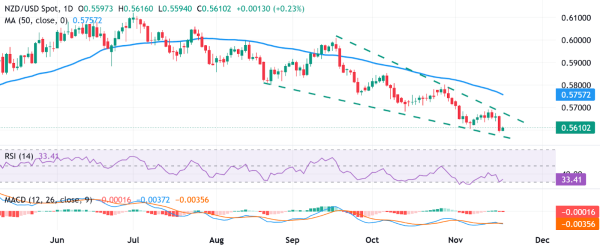The NZD/USD pair has attracted some buyers on Thursday, recovering a portion of the previous day’s sharp losses that dragged the pair to the lowest levels since April 9. Spot prices are holding intraday gains above the 0.5600 mark through the early European session, signaling a modest recovery after recent downside pressure. This article by Fimatron offers expert insights and a complete explanation of the subject.
However, the broader upside appears capped due to a firmer US Dollar (USD), as traders await the crucial US Nonfarm Payrolls (NFP) report for September. The delayed NFP release has intensified volatility expectations, with market participants positioning for potential short-term swings in risk sentiment and currency valuations.
Technical Outlook: Formation of a Bullish Falling Wedge
From a technical perspective, the recent downturn in NZD/USD over the past two months has unfolded along converging trend lines, creating the classic pattern of a bullish falling wedge on the daily chart. This structure often signals potential trend reversals, favoring bullish traders.
The falling wedge pattern is confirmed by progressively lower highs and lower lows that converge towards a narrowing support zone, indicating a loss of downward momentum. Despite this, repeated failures to break above the 50-day Simple Moving Average (SMA) and lingering negative oscillator readings, such as the Relative Strength Index (RSI) and MACD, warrant caution before positioning aggressively for further upside gains.
Key Resistance Levels to Watch
For the near term, any recovery move is likely to encounter resistance near the 0.5665–0.5670 zone, representing the upper boundary of the falling wedge. A break above this level could trigger follow-through buying, potentially initiating a short-covering rally and lifting NZD/USD towards the 0.5700 mark.
Beyond that, the 50-day SMA, currently located around 0.5765, represents a pivotal resistance level. A sustained move above this level would confirm that spot prices have bottomed out and could mark the end of the near-term downtrend, signaling a potential trend reversal for the NZD/USD pair.
Traders will also monitor intraday momentum indicators, such as the Stochastic Oscillator, to gauge the strength of upside moves. A positive divergence between the price action and oscillators could provide additional confirmation for a rebound scenario, whereas a failure to sustain above key resistance could signal a continuation of the prevailing bearish trend.
Fundamental Drivers Shaping NZD/USD Ahead of US Jobs Data
Beyond technical setups, fundamental factors are playing a crucial role in NZD/USD price action. The New Zealand Dollar remains sensitive to commodity prices, especially dairy exports, which support the country’s trade balance and overall economic growth. Meanwhile, the US Dollar is benefiting from expectations of tighter monetary policy and strong labor market data, reinforcing its safe-haven appeal.

Support Levels and Bearish Risks
On the downside, a break below the 0.5600 round figure and a subsequent breach of the falling wedge support, around 0.5570–0.5565, could trigger renewed selling pressure. Such a move may accelerate NZD/USD’s downfall, potentially testing multi-year lows near the 0.5500 psychological mark.
Failure to hold critical support zones would likely extend the nearly four-month-old downtrend, prompting bearish traders to increase short positions. Technical analysts will also watch for volume spikes during downside moves, as these could indicate stronger selling momentum and reinforce the bearish bias.
NFP Impact on NZD/USD Volatility
The upcoming US Nonfarm Payrolls (NFP) report is expected to significantly influence NZD/USD trading in the short term. A stronger-than-expected NFP print would likely boost the USD, putting further downside pressure on the New Zealand Dollar. Conversely, a weaker report could alleviate USD strength, allowing NZD/USD to extend its modest recovery towards the falling wedge breakout zone.
Traders should also consider broader market sentiment, including risk appetite, commodity prices, and interest rate expectations, as these factors tend to interact with technical signals and affect currency volatility around major economic data releases.

Summary and Outlook
In summary, NZD/USD has managed to recover modestly above 0.5600, supported by buyers stepping in following recent declines. The formation of a bullish falling wedge provides a technical basis for a near-term rebound, though negative oscillators and repeated resistance near the 50-day SMA advise caution.
Upside targets include the 0.5665–0.5670 zone, with a potential extension to 0.5700 and the 50-day SMA near 0.5765 if buying momentum persists. Downside risk remains if support at 0.5600 and falling wedge boundaries are broken, potentially resuming the multi-month downtrend toward 0.5500.
Ultimately, the US NFP report is expected to act as a key catalyst, influencing intraday volatility and determining whether NZD/USD can sustain its recovery or resume the broader downtrend. Traders are advised to monitor technical levels, oscillator signals, and NFP outcomes closely to make informed trading decisions.









